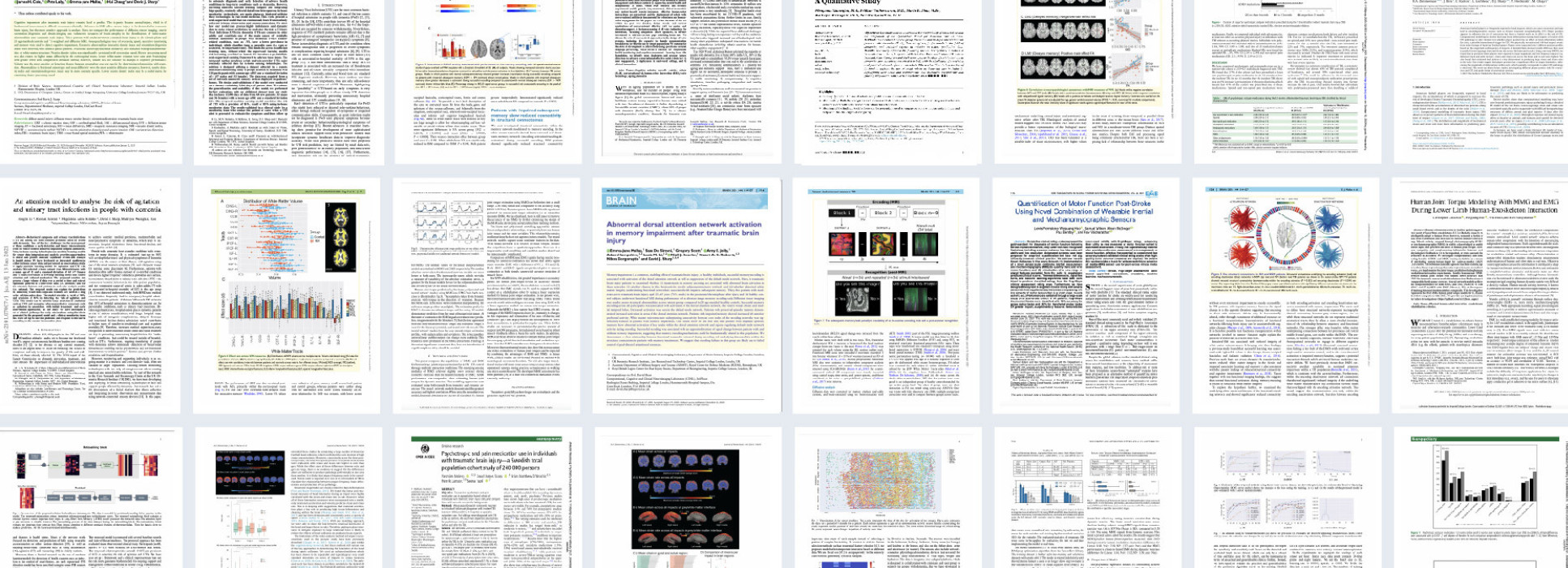
Results
- Showing results for:
- Reset all filters
Search results
-
Conference paperChen Z, Bannon A, Rapeaux A, et al., 2021,
Towards robust, unobtrusive sensing of respiration using UWB impulse Radar for the care of people living with dementia
, 10th International IEEE-EMBS Conference on Neural Engineering (NER), Publisher: IEEE, Pages: 866-871, ISSN: 1948-3546The unobtrusive monitoring of vital signals and behaviour can be used to gather intelligence to support the care of people living with dementia. This can provide insights into the person's wellbeing and the neurogenerative process, as well as enable them to continue to live safely at home, thereby improving their quality of life. Within this context, this study investigated the deployability of non-contact respiration rate (RR) measurement based on an Ultra-Wideband (UWB) radar System-on-Chip (SoC). An algorithm was developed to simultaneously and continuously extract the respiration signal, together with the confidence level of the respiration signal and the target position, without needing any prior calibration. The radar-measured RR results were compared to the RR results obtained from a ground truth measure based on the breathing sound, and the error rates were within 8% with a mean value of 2.5%. The target localisation results match to the radar-to-chest distances with a mean error rate of 5.8%. The tested measurement range was up to 5m. The results suggest that the algorithm could perform sufficiently well in non-contact stationary respiration rate detection.
-
Journal articleTiersen F, Batey P, Harrison MJC, et al., 2021,
Smart home sensing and monitoring in households with dementia: user-centered design approach
, JMIR Aging, Vol: 4, Pages: 1-20, ISSN: 2561-7605Background:As life expectancy grows, so do the challenges of caring for an ageing population. Older adults, including people with dementia, want to live independently and feel in control of their lives for as long as possible. Assistive technologies powered by Artificial Intelligence and Internet of Things devices are being proposed to provide living environments that support the users’ safety, psychological, and medical needs through remote monitoring and interventions.Objective:This study investigates the functional, psychosocial, and environmental needs of people living with dementia, their caregivers, clinicians, and health and social care service providers towards the design and implementation of smart home systems.Methods:We used an iterative user-centered design approach comprising nine sub-studies. First, semi-structured interviews (N = 9 people with dementia, 9 caregivers, 10 academic and clinical staff), ethnographic observations in clinics (N = 10 people with dementia, 10 caregivers, 3 clinical monitoring team members), and workshops (N = 35 pairs of people with dementia and caregivers, 12 health and social care clinicians) were conducted to define the needs of people with dementia, home caregivers and professional stakeholders in both daily activities and technology-specific interactions. Then, the spectrum of needs identified was represented via patient-caregiver personas and discussed with stakeholders in a workshop (N = 14 occupational therapists, 4 National Health Service pathway directors, 6 researchers in occupational therapy, neuropsychiatry and engineering) and two focus groups with managers of healthcare services (N = 8), eliciting opportunities for innovative care technologies and public health strategies. Finally, these opportunities were discussed in semi-structured interviews with participants of a smart home trial involving environmental sensors, physiological measurement devices, smart watches, and tablet-based chatbots and cognitive
-
Journal articleMolero Y, Sharp DJ, Onofrio BMD, et al., 2021,
Psychotropic and pain medication use in individuals with traumatic brain injury-a Swedish total population cohort study of 240 000 persons
, JOURNAL OF NEUROLOGY NEUROSURGERY AND PSYCHIATRY, Vol: 92, Pages: 519-527, ISSN: 0022-3050- Author Web Link
- Cite
- Citations: 3
-
Journal articleFirouzi F, Farahani B, Daneshmand M, et al., 2021,
Harnessing the power of smart and connected health to tackle COVID-19: IoT, AI, Robotics, and Blockchain for a better world
, IEEE Internet of Things Journal, Vol: 8, Pages: 12826-12846, ISSN: 2327-4662As COVID-19 hounds the world, the common cause of finding a swift solution to manage the pandemic has brought together researchers, institutions, governments, and society at large. The Internet of Things (IoT), Artificial Intelligence (AI) — including Machine Learning (ML) and Big Data analytics — as well as Robotics and Blockchain, are the four decisive areas of technological innovation that have been ingenuity harnessed to fight this pandemic and future ones. While these highly interrelated smart and connected health technologies cannot resolve the pandemic overnight and may not be the only answer to the crisis, they can provide greater insight into the disease and support frontline efforts to prevent and control the pandemic. This paper provides a blend of discussions on the contribution of these digital technologies, propose several complementary and multidisciplinary techniques to combat COVID-19, offer opportunities for more holistic studies, and accelerate knowledge acquisition and scientific discoveries in pandemic research. First, four areas where IoT can contribute are discussed, namely, i) tracking and tracing, ii) Remote Patient Monitoring (RPM) by Wearable IoT (WIoT), iii) Personal Digital Twins (PDT), and iv) real-life use case: ICT/IoT solution in Korea. Second, the role and novel applications of AI are explained, namely: i) diagnosis and prognosis, ii) risk prediction, iii) vaccine and drug development, iv) research dataset, v) early warnings and alerts, vi) social control and fake news detection, and vii) communication and chatbot. Third, the main uses of robotics and drone technology are analyzed, including i) crowd surveillance, ii) public announcements, iii) screening and diagnosis, and iv) essential supply delivery. Finally, we discuss how Distributed Ledger Technologies (DLTs), of which blockchain is a common example, can be combined with other technologies for tackling COVID-19.
-
Journal articleDuckworth H, Sharp DJ, Ghajari M, 2021,
Smoothed particle hydrodynamic modelling of the cerebrospinal fluid for brain biomechanics: accuracy and stability
, International Journal for Numerical Methods in Biomedical Engineering, Vol: 37, ISSN: 1069-8299The Cerebrospinal Fluid (CSF) can undergo shear deformations under head motions. Finite Element (FE) models, which are commonly used to simulate biomechanics of the brain, including traumatic brain injury, employ solid elements to represent the CSF. However, the limited number of elements paired with shear deformations in CSF can decrease the accuracy of their predictions. Large deformation problems can be accurately modelled using the mesh-free Smoothed Particle Hydrodynamics (SPH) method, but there is limited previous work on using this method for modelling the CSF. Here we explored the stability and accuracy of key modelling parameters of an SPH model of the CSF when predicting relative brain/skull displacements in a simulation of an in vivo mild head impact in human. The Moving Least Squares (MLS) SPH formulation and Ogden rubber material model were found to be the most accurate and stable. The strain and strain rate in the brain differed across the SPH and FE models of CSF. The FE mesh anchored the gyri, preventing them from experiencing the level of strains seen in the in vivo brain experiments and predicted by the SPH model. Additionally, SPH showed higher levels of strains in the sulci compared to the FE model. However, tensile instability was found to be a key challenge of the SPH method, which needs to be addressed in future. Our study provides a detailed investigation of the use of SPH and shows its potential for improving the accuracy of computational models of brain biomechanics.
This data is extracted from the Web of Science and reproduced under a licence from Thomson Reuters. You may not copy or re-distribute this data in whole or in part without the written consent of the Science business of Thomson Reuters.
Awards
- Finalist: Best Paper - IEEE Transactions on Mechatronics (awarded June 2021)
- Finalist: IEEE Transactions on Mechatronics; 1 of 5 finalists for Best Paper in Journal
- Winner: UK Institute of Mechanical Engineers (IMECHE) Healthcare Technologies Early Career Award (awarded June 2021): Awarded to Maria Lima (UKDRI CR&T PhD candidate)
- Winner: Sony Start-up Acceleration Program (awarded May 2021): Spinout company Serg Tech awarded (1 of 4 companies in all of Europe) a place in Sony corporation start-up boot camp
- “An Extended Complementary Filter for Full-Body MARG Orientation Estimation” (CR&T authors: S Wilson, R Vaidyanathan)

Established in 2017 by its principal funder the Medical Research Council, in partnership with Alzheimer's Society and Alzheimer’s Research UK, The UK Dementia Research Institute (UK DRI) is the UK’s leading biomedical research institute dedicated to neurodegenerative diseases.


